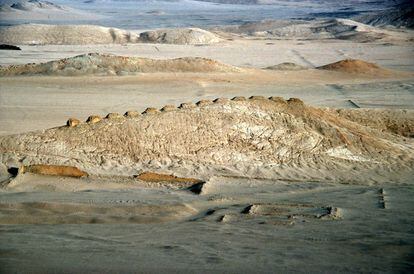"We are very happy!", Was the first reaction of the authority of Culture of the Ancash region, Rosario Oliva, after Unesco inscribed in the list of World Heritage the archaeological complex and astronomical observatory Chankillo, a site located in the The coastal and desert province of Casma, some 300 kilometers north of Lima, which was affected by illegal crops during the pandemic.
According to the investigations of archaeologist Ivan Ghezzi, the main promoter of the inclusion of Chankillo in the World Heritage list, the ancient Peruvians made astronomical observations there 2,000 years ago and created the complex to venerate the sun, the main deity of the prehispanic world.
More news
3D resurrects the splendor of six World Heritage Sites in danger
UNESCO celebrates half a century in the fight against the multimillion-dollar looting of cultural property
Madrid enters the World Heritage list
Considered the oldest solar observatory in America, Chankillo joins two other places recognized as world heritage by UNESCO in the Peruvian region of Ancash: the Chavín archaeological complex (1985) and an area of the Inca trail or Qhapac Ñan (2014), according to Oliva reported.
The Minister of Culture, Alejandro Neyra, stressed this Tuesday that this Unesco declaration turns the province of Casma into "an area with several attractions" that can be covered in one day.
Near the astronomical observatory is Caral, the oldest sacred city on the continent, also inscribed on the world heritage list in 2009, and in the surroundings there is also the architectural complex of Sechín.
The astronomical complex in Casma consists of a series of constructions built in a desert landscape and with natural characteristics that together "function as a perfect solar calendar, using markers that allow observing the movement of the sun along the horizon throughout the year." , details the Unesco file.
The observatory allows us to notice the change of seasons, the solstices and equinoxes, which for the archaeologist Ghezzi is a new example of the "technology and creativity" that the ancient Peruvians possessed.
The complex is made up of the so-called fortified temple that is surrounded by three walls on top of a hill.
In addition, there is the observatory and the ceremonial public space and the thirteen towers, signaling the solar path on the top of another hill.
As a natural indicator of the astronomical site is Cerro Mucho Malo, complementary to the towers.
Join EL PAÍS now to follow all the news and read without limits
Subscribe here
According to Ghezzi's research, measurements of equinoxes, solstices and any date of the year had a margin of error of only one or two days, using the solar cycle and an artificial horizon.
Unesco has recognized the complex as a masterpiece not only of astronomy, but also of engineering and architecture, the archaeologist told
Radioprogramas
.
"Chankillo was the cradle of astronomy to measure the passage of the sun," he assured.
According to a statement from the Ministry of Culture, Chankillo is one of two places in the ancient world that have incorporated a full solar horizon calendar.
Illegal crops and invasions
Oliva, head of the Decentralized Directorate of Culture of Ancash, has told this newspaper that the Unesco recognition will serve to request "more economic support and generate interest in the archaeological complex and the commitment of the population of the area", where, in addition of illegal crops, there have been “invasions of mat houses”.
In May last year, in the midst of a pandemic, Ghezzi reported that farmers invaded the archaeological zone, planted mango plants and dug a 15-meter deep water well.
In the Casma Valley, where Chankillo is located, some agro-export companies from the Andean country operate.
Undated photo of the Chankillo solar observatory.Ministry of Culture HANDOUT / EFE
The Ministry of Culture and the police reacted quickly to remove the crops from the complex, because one of the criteria evaluated by Unesco to include the sites as World Heritage is the management capacity of the State and the citizens of neighboring areas. The archaeologist then stressed that the local population alerted him to the invasion, and not the authorities.
The Ancash Culture official explained that the excavations that Ghezzi has carried out in the last decade to propose to Unesco the recognition of Chankillo have been financed by the
World Monuments Fund
, while the Municipality of Casma paid the team that prepared the management plan of the archaeological site, made up of geographers, surveyors and environmental experts.
The municipality also bears the costs of security guards, although it does not consider them sufficient.
"The area is very large and more support is needed to advance tourism in the area," he said.
Subscribe here to the
EL PAÍS América
newsletter
and receive all the information keys on the region's current affairs

